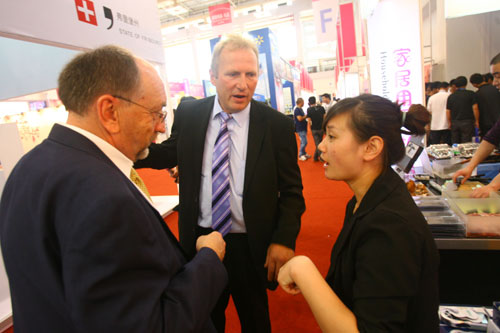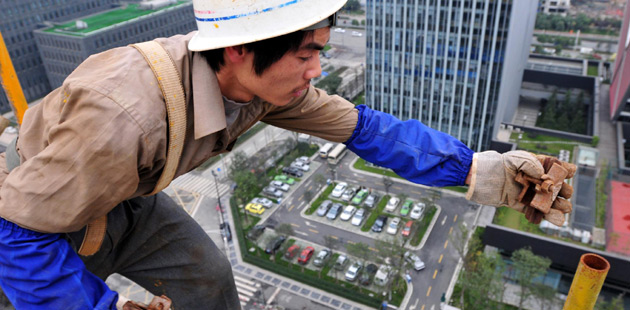FDI focus continues to shift
Updated: 2011-12-16 09:40
By Ding Qingfen (China Daily)
|
|||||||||||
Strategy to transform the economic development model gets a boost
BEIJING - Despite the reshoring of manufacturing activity to the developed economies, China is well on track with the diversification of its industrial structure, moving the focus of foreign direct investment (FDI) from the manufacturing sector, in line with the country's new FDI policy, said government officials.
|
 |
|
Overseas visitors attending an investment and trade fair in Ningbo, Zhejiang province. China's foreign direct investment surged by 13.15 percent year-on-year to $103.77 billion during the first 11 months of this year.[Photo/China Daily] |
While labor costs in China continue to rise and the developed nations, including the United States, strengthen their efforts to attract FDI to boost the economy and create jobs, China's FDI from the US and the European Union (EU) has either been in decline or slowing down.
Government officials and experts attribute the decline in FDI to the reshoring of manufacturing activity, which means foreign companies moving factories from China to their countries of origin.
But the officials said reshoring is only a small part of the story and not necessarily a bad thing, believing that the structure of China's FDI is changing with a move away from low-end manufacturing towards those sectors that could help China to transform its economic growth model, including services, high-tech, new-energy and high-end manufacturing.
US investment decreased by 23.05 percent year-on-year to $2.74 billion between January and October, and investment from the 27 nations of the EU gained slightly by 0.29 percent to $5.98 billion, according to the Ministry of Commerce.
But overall, the nation's FDI surged by 13.15 percent to $103.77 billion during the first 11 months of this year, close to the total for the whole of 2010.
"So far, this year has been ok for Zhejiang in attracting FDI, but next year will not be as positive. We will probably see a drop in FDI in 2012," Chen Rufang, deputy director-general of commerce for the province, predicted.
Chen connected the possible decline with the "European debt woes". "Now that the EU economy is in turmoil, the outlook for the global economy is also grim and investment confidence is also dampened," he said.
Besides the gloomy global economic situation, developed nations have also rolled out preferential policies to attract investment and stimulate their economies.
The US is currently making intensive efforts to attract more FDI. In June, President Barack Obama announced that the US is committed to enhancing its competitiveness to attract more investment, especially from China.
A national investment promotion agency has been established along with a new "Select US" office, involving 23 government departments.
Shen Danyang, spokesman for China's Ministry of Commerce, said the decline in investment from the US and EU is related to the reshoring of manufacturing activity and a weaker global economy, which has had an effect on China's FDI. However, Shen refuted the notion that reshoring is likely to become a broader trend.
In Guangdong province, the region that attracts the most FDI, investment from the US and EU is also decreasing. However, the province is still pulling in FDI on the back of a number of emerging markets including Russia and the ASEAN countries.
"This trend will continue," said Chen Yongfang, deputy director of the Guangzhou Foreign Trade and Economic Cooperation Bureau.
Because of the low cost of labor, Guangdong has long been able to boast a large number of manufacturing bases owned by international companies that import raw materials and components and export the finished products around the world.
But with rising wages a national phenomenon and developed nations offering preferential policies to encourage investment to their own countries, some overseas companies are moving their factories back to the country of origin or to other Asian countries that have a plentiful supply of cheap labor.
But, "the bad side of the story is only the small part, and the other big part is more positive. We notice that an increasing number of companies from the developed nations are adding investment here (in China) in sectors such as high-tech, services and research and development (R&D)", said Chen.
Official figures speak volumes: According to the Ministry of Commerce, foreign investment flowing into the manufacturing sector grew by 11.69 percent to $43.59 billion between January and October, from the same period a year earlier. The growth of overall investment flowing into China was 15.86 percent during that period.
For the first time ever, FDI in the service sector overtook manufacturing, gaining by 18.54 percent to $48.77 billion between January and October, with industries such as tourism, transportation and entertainment at the top of the list.
"This sort of transformation fits well with China's new FDI policy and the nation's economic growth plan for the next five years. It's a good change," Chen said.
In April 2010, the State Council, the country's top policy body, launched new guidelines for the development of FDI, emphasizing that China encourages foreign companies to invest in sectors such as services, high-tech, and new-energy, and in the nation's central and western regions, as part of the transformation of the economic development model.
"The fact is, the value of investment from the US and EU is decreasing, but the number of cases of investment is not falling," said Yang Jianzhong, deputy secretary of Suzhou Industrial Park Administration Committee, referring to events in Jiangsu province.
Suzhou Industrial Park plays host to many international companies in the eastern region of China, where provinces such as Jiangsu lead in the race to attract FDI.
"Rather than manufacturing bases, more and more (funds) went and will go to sectors such as services and R&D, which usually require less in terms of investment. This is why the value of investment has shrunk," explained Yang.
In Guangdong, the actual FDI in the region grew by 8 percent between January and September, but newly approved cases rose by 35.97 percent over the same period.
Many overseas companies see sectors such as services and the high-tech industry as the best places to invest.
Pearson PLC, the UK-based educational publisher company, recently said it will pay $294 million for the US-listed Global Education and Technology Group, a Chinese provider of English language services, eyeing the rapidly rising demand for English language education in the country.
The move follows Pearson's announcement of an expansion plan to open 50 new English language centers in China last year.
The US-based hotel management group Marriott International Inc,which currently operates 56 hotels in China representing the Ritz-Carlton, JW Marriott and Renaissance brands, said it has a pipeline of confirmed projects totaling 44 hotels nationwide.
"Since the outbreak of the financial crisis in 2008, the international companies have stepped up their globalization efforts to lower the risks in individual markets. China has proved to be the best place," said Wang Zhile, director of the research center on transnational corporations at the commerce ministry.
"Huge market consumption, comparatively lower labor costs and a well-developed industrial chain are making it (China) very attractive."
In spite of the move away from low-end manufacturing, foreign companies in market-oriented or high-end manufacturing are still adding investment in China.
In August, the healthcare giant Abbott Laboratories Inc announced that it would invest $230 million to establish a nutritional products factory in Jiaxing, Zhejiang province, the company's largest investment in China.
The world's largest provider of earthmoving equipment, Caterpillar Inc, has agreed a deal worth $886 million to purchase ERA Mining Machinery Ltd, a Chinese manufacturer of underground coal-mining equipment. The deal could help Caterpillar to make further inroads in the Chinese mining-equipment market where operators tend to prefer local brands over US equipment.
According to the Ministry of Human Resources and Social Security, by the end of September this year, 21 provinces and regions had increased minimum wages by an average 21.7 percent, and several more have promised to follow suit before the end of the year.








